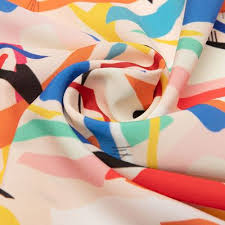Transforming Textiles with Technology: The Rise of Digital Printing on FabricIn the modern textile industry, innovation is reshaping how fabrics are designed and produced. One of the most revolutionary advancements is digital printing on fabric, a technology that merges the precision of digital design with the creativity of textile art. Unlike traditional screen or rotary printing, digital fabric printing uses advanced inkjet technology to apply designs directly onto textiles. This not only enhances efficiency but also opens new possibilities for personalization, sustainability, and creative freedom. As the demand for fast fashion, home décor, and custom-designed fabrics continues to grow, digital printing is becoming the go-to choice for textile manufacturers, designers, and artists worldwide. Let’s explore how this technology works, its benefits, and its impact on the global textile landscape. What is Digital Printing on Fabric? Digital printing on fabric is a modern method that involves printing digital designs directly onto textiles using inkjet printers. Specialized textile inks—such as reactive, pigment, sublimation, or acid dyes—are used depending on the fabric type. The process is controlled by computer software that translates the digital design into precise color applications, ensuring high-quality prints with incredible detail. This method differs from traditional textile printing, which requires multiple screens and color separations. Digital printing eliminates these limitations, allowing manufacturers to produce complex, multicolored designs quickly and efficiently. How Digital Fabric Printing Works The digital printing process involves several key steps: 1. Design Creation Designers use graphic software like Adobe Photoshop or CorelDRAW to create or modify designs digitally. The digital format allows easy adjustments to color, pattern, and scale. 2. Fabric Preparation Before printing, the fabric is pre-treated with a chemical coating that helps the ink adhere better and improves color vibrancy. 3. Printing Process The prepared fabric is loaded into a digital textile printer. The printer sprays tiny droplets of ink directly onto the material based on the digital design. This ensures accurate color reproduction and intricate detailing. 4. Fixation and Washing Once the printing is complete, the fabric goes through heat or steam treatment to fix the colors permanently. Finally, it is washed and dried to remove any residue, resulting in a finished printed textile ready for use. Types of Digital Printing on Fabric Different printing techniques are used based on fabric composition and application requirements: Direct-to-Fabric (DTF) Printing In this method, inks are applied directly to the fabric surface. It is suitable for cotton, silk, and linen. Reactive or pigment inks are commonly used for DTF printing. Dye Sublimation Printing This technique is ideal for polyester or synthetic fabrics. The design is first printed on a special transfer paper and then heat-pressed onto the fabric. The heat converts the dye into gas, which bonds with the fibers, resulting in vibrant, durable prints. Reactive Printing Reactive dyes chemically bond with natural fibers, providing excellent colorfastness and a soft hand feel. This method is popular for high-quality fashion and home textile production. Pigment Printing Pigment inks sit on the fabric’s surface rather than penetrating the fibers. This method is versatile, eco-friendly, and works well on both natural and synthetic fabrics. Advantages of Digital Printing on Fabric Digital textile printing offers numerous benefits that have made it a game-changer in the textile world: High-Quality and Precision Digital printing allows for sharp, vibrant, and detailed designs. Even the most complex patterns with gradient tones or fine lines can be produced flawlessly. Customization and Flexibility One of the most significant advantages is the ability to create customized fabrics in small or large quantities. Designers can easily alter colors or patterns, making the process ideal for personalized clothing, home décor, or promotional materials. Eco-Friendly Process Traditional fabric printing consumes large amounts of water and generates chemical waste. Digital printing, on the other hand, uses less water, energy, and ink, making it a sustainable alternative. Faster Production With no need for screens or setup, digital printing drastically reduces production time. It allows for rapid prototyping and quicker delivery to market, especially beneficial for the fast fashion industry. Cost-Effective for Small Batches Unlike traditional methods that require large production runs to be cost-effective, digital printing is economical for both small and large quantities. Applications of Digital Printing in the Textile Industry Digital fabric printing is used across multiple industries due to its versatility and efficiency. Fashion and Apparel Designers use digital printing to create unique, high-fashion garments with intricate patterns and colors. It supports limited-edition collections and rapid design experimentation. Home Furnishings From curtains and upholstery to bed linens and cushions, digital printing allows homeowners and designers to achieve personalized, stylish interiors. Sportswear and Activewear Sublimation printing on polyester fabrics produces vibrant, durable designs perfect for activewear and sports uniforms. Soft Signage and Advertising Banners, flags, and exhibition backdrops often use digitally printed fabrics due to their lightweight, durable, and visually appealing finish. Customized Merchandise Brands and individuals use digital printing for creating custom T-shirts, scarves, bags, and other promotional items. Challenges in Digital Fabric Printing While the advantages are many, there are some challenges manufacturers face: High Initial Investment: Advanced printers and inks can be expensive. Color Management: Achieving consistent colors across different fabric types requires precise calibration. Fabric Limitations: Certain materials, especially blended or stretch fabrics, may not absorb ink evenly. Durability Concerns: Some prints, particularly those using pigment inks, may have lower wash durability compared to traditional dyes. Despite these challenges, ongoing research and technological advancements are addressing these issues, making digital fabric printing more reliable and efficient every year. Sustainability in Digital Textile Printing Sustainability is one of the most compelling aspects of digital printing. By reducing water and chemical waste, this technology aligns with global efforts toward eco-friendly textile manufacturing. Many manufacturers are adopting water-based inks and energy-efficient printing machines to minimize environmental impact. Furthermore, digital printing supports on-demand production, reducing fabric waste and overproduction — a major concern in traditional textile processes. This sustainable approach benefits both businesses and the planet. Future of Digital Printing on Fabric The future of digital printing on fabric is bright and promising. With the integration of AI-driven design software, smart inks, and automation, the process is becoming faster, more precise, and environmentally responsible. As consumers increasingly prefer customized and sustainable fashion, digital printing will continue to lead the transformation in textile manufacturing. Emerging technologies like 3D printing on textiles and biodegradable inks are expected to further enhance the potential of this field. The industry is heading toward a future where design creativity meets technological excellence. Frequently Asked Questions (FAQs) What is the main advantage of digital printing on fabric? The main advantage is its ability to produce high-quality, detailed designs quickly and efficiently without the need for screens or setup, allowing for customization and small-batch production. Which fabrics are best suited for digital printing? Cotton, silk, polyester, linen, and blends are commonly used, depending on the printing method and ink type. Is digital fabric printing environmentally friendly? Yes. It consumes less water and energy and produces minimal waste, making it a sustainable option compared to traditional printing methods. Can digital printing be used for both small and large production runs? Absolutely. It is cost-effective for small batches and scalable for large runs, offering great flexibility to manufacturers. How durable are digitally printed fabrics? Durability depends on the ink and fabric type. Reactive and sublimation prints tend to have excellent wash and colorfastness properties. Conclusion Digital printing on fabric has revolutionized the textile industry, offering unmatched precision, speed, and creative flexibility. It bridges the gap between art and technology, allowing designers to turn digital ideas into tangible, beautiful textiles. With its sustainable nature, efficiency, and potential for customization, digital fabric printing is not just a trend—it’s the future of textile manufacturing. As industries continue to evolve toward eco-conscious and on-demand production, digital printing stands at the forefront, transforming how fabrics are created, designed, and appreciated worldwide.
October 21, 2025 | by IoT Development Company

In the modern textile industry, innovation is reshaping how fabrics are designed and produced. One of the most revolutionary advancements is digital printing on fabric, a technology that merges the precision of digital design with the creativity of textile art. Unlike traditional screen or rotary printing, digital fabric printing uses advanced inkjet technology to apply designs directly onto textiles. This not only enhances efficiency but also opens new possibilities for personalization, sustainability, and creative freedom.
As the demand for fast fashion, home décor, and custom-designed fabrics continues to grow, digital printing is becoming the go-to choice for textile manufacturers, designers, and artists worldwide. Let’s explore how this technology works, its benefits, and its impact on the global textile landscape.
What is Digital Printing on Fabric?
Digital printing on fabric is a modern method that involves printing digital designs directly onto textiles using inkjet printers. Specialized textile inks—such as reactive, pigment, sublimation, or acid dyes—are used depending on the fabric type. The process is controlled by computer software that translates the digital design into precise color applications, ensuring high-quality prints with incredible detail.
This method differs from traditional textile printing, which requires multiple screens and color separations. Digital printing eliminates these limitations, allowing manufacturers to produce complex, multicolored designs quickly and efficiently.
How Digital Fabric Printing Works
The digital printing process involves several key steps:
1. Design Creation
Designers use graphic software like Adobe Photoshop or CorelDRAW to create or modify designs digitally. The digital format allows easy adjustments to color, pattern, and scale.
2. Fabric Preparation
Before printing, the fabric is pre-treated with a chemical coating that helps the ink adhere better and improves color vibrancy.
3. Printing Process
The prepared fabric is loaded into a digital textile printer. The printer sprays tiny droplets of ink directly onto the material based on the digital design. This ensures accurate color reproduction and intricate detailing.
4. Fixation and Washing
Once the printing is complete, the fabric goes through heat or steam treatment to fix the colors permanently. Finally, it is washed and dried to remove any residue, resulting in a finished printed textile ready for use.
Types of Digital Printing on Fabric
Different printing techniques are used based on fabric composition and application requirements:
Direct-to-Fabric (DTF) Printing
In this method, inks are applied directly to the fabric surface. It is suitable for cotton, silk, and linen. Reactive or pigment inks are commonly used for DTF printing.
Dye Sublimation Printing
This technique is ideal for polyester or synthetic fabrics. The design is first printed on a special transfer paper and then heat-pressed onto the fabric. The heat converts the dye into gas, which bonds with the fibers, resulting in vibrant, durable prints.
Reactive Printing
Reactive dyes chemically bond with natural fibers, providing excellent colorfastness and a soft hand feel. This method is popular for high-quality fashion and home textile production.
Pigment Printing
Pigment inks sit on the fabric’s surface rather than penetrating the fibers. This method is versatile, eco-friendly, and works well on both natural and synthetic fabrics.
Advantages of Digital Printing on Fabric
Digital textile printing offers numerous benefits that have made it a game-changer in the textile world:
High-Quality and Precision
Digital printing allows for sharp, vibrant, and detailed designs. Even the most complex patterns with gradient tones or fine lines can be produced flawlessly.
Customization and Flexibility
One of the most significant advantages is the ability to create customized fabrics in small or large quantities. Designers can easily alter colors or patterns, making the process ideal for personalized clothing, home décor, or promotional materials.
Eco-Friendly Process
Traditional fabric printing consumes large amounts of water and generates chemical waste. Digital printing, on the other hand, uses less water, energy, and ink, making it a sustainable alternative.
Faster Production
With no need for screens or setup, digital printing drastically reduces production time. It allows for rapid prototyping and quicker delivery to market, especially beneficial for the fast fashion industry.
Cost-Effective for Small Batches
Unlike traditional methods that require large production runs to be cost-effective, digital printing is economical for both small and large quantities.
Applications of Digital Printing in the Textile Industry
Digital fabric printing is used across multiple industries due to its versatility and efficiency.
Fashion and Apparel
Designers use digital printing to create unique, high-fashion garments with intricate patterns and colors. It supports limited-edition collections and rapid design experimentation.
Home Furnishings
From curtains and upholstery to bed linens and cushions, digital printing allows homeowners and designers to achieve personalized, stylish interiors.
Sportswear and Activewear
Sublimation printing on polyester fabrics produces vibrant, durable designs perfect for activewear and sports uniforms.
Soft Signage and Advertising
Banners, flags, and exhibition backdrops often use digitally printed fabrics due to their lightweight, durable, and visually appealing finish.
Customized Merchandise
Brands and individuals use digital printing for creating custom T-shirts, scarves, bags, and other promotional items.
Challenges in Digital Fabric Printing
While the advantages are many, there are some challenges manufacturers face:
-
High Initial Investment: Advanced printers and inks can be expensive.
-
Color Management: Achieving consistent colors across different fabric types requires precise calibration.
-
Fabric Limitations: Certain materials, especially blended or stretch fabrics, may not absorb ink evenly.
-
Durability Concerns: Some prints, particularly those using pigment inks, may have lower wash durability compared to traditional dyes.
Despite these challenges, ongoing research and technological advancements are addressing these issues, making digital fabric printing more reliable and efficient every year.
Sustainability in Digital Textile Printing
Sustainability is one of the most compelling aspects of digital printing. By reducing water and chemical waste, this technology aligns with global efforts toward eco-friendly textile manufacturing. Many manufacturers are adopting water-based inks and energy-efficient printing machines to minimize environmental impact.
Furthermore, digital printing supports on-demand production, reducing fabric waste and overproduction — a major concern in traditional textile processes. This sustainable approach benefits both businesses and the planet.
Future of Digital Printing on Fabric
The future of digital printing on fabric is bright and promising. With the integration of AI-driven design software, smart inks, and automation, the process is becoming faster, more precise, and environmentally responsible. As consumers increasingly prefer customized and sustainable fashion, digital printing will continue to lead the transformation in textile manufacturing.
Emerging technologies like 3D printing on textiles and biodegradable inks are expected to further enhance the potential of this field. The industry is heading toward a future where design creativity meets technological excellence.
Frequently Asked Questions (FAQs)
What is the main advantage of digital printing on fabric?
The main advantage is its ability to produce high-quality, detailed designs quickly and efficiently without the need for screens or setup, allowing for customization and small-batch production.
Which fabrics are best suited for digital printing?
Cotton, silk, polyester, linen, and blends are commonly used, depending on the printing method and ink type.
Is digital fabric printing environmentally friendly?
Yes. It consumes less water and energy and produces minimal waste, making it a sustainable option compared to traditional printing methods.
Can digital printing be used for both small and large production runs?
Absolutely. It is cost-effective for small batches and scalable for large runs, offering great flexibility to manufacturers.
How durable are digitally printed fabrics?
Durability depends on the ink and fabric type. Reactive and sublimation prints tend to have excellent wash and colorfastness properties.
Conclusion
Digital printing on fabric has revolutionized the textile industry, offering unmatched precision, speed, and creative flexibility. It bridges the gap between art and technology, allowing designers to turn digital ideas into tangible, beautiful textiles. With its sustainable nature, efficiency, and potential for customization, digital fabric printing is not just a trend—it’s the future of textile manufacturing.
As industries continue to evolve toward eco-conscious and on-demand production, digital printing stands at the forefront, transforming how fabrics are created, designed, and appreciated worldwide.
RELATED POSTS
View all



